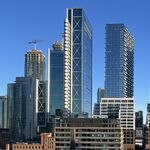A
AlvinofDiaspar
Guest
By R Ouellette, taken from Reading Toronto, cross published in the Post:
2006 07 01
The New Suburbia
Are the suburbs on the verge of becoming urban destinations?
With Toronto’s waterfront and the Four Seasons Centre for the Performing Arts attracting much deserved media attention, changes taking place at the edge of the city have escaped unnoticed. That is too bad because the City of Vaughan may be about to challenge the way we think about suburbs by creating a civic space as engaging as any found in Toronto.
For years, Toronto residents watched awestruck as small towns north of the city sprawled their way into full-fledged cities. Vaughan is an example. About 29,000 people lived there in 1981. By 2001, that number grew to 185,000. With growth that fast, there is little time for attention to details – build one street, move on to the next and add a strip mall destination for cars on the corner – fast.
The result is, of course, that many of these suburban cities lack the considered civic and urban amenities that provide older cities a sense of place and community. Cars are king. Do you ever wonder why some 20,000 suburban kids flood into downtown Toronto on Saturday nights? This might just be one of the reasons: they hunger for a sense of cultural identity.
Bucking the trend, politicians in Vaughan wanted a civic centre to focus their community’s unique identity in a distinctly urban way.
They held a design competition. Toronto’s KPMB Architects won by re-imagining what a suburban city centre could look like. Here is how they did it and why Torontonians might soon be going north for a unique urban experience.
Rather than design a tall office tower surrounded by a sea of asphalt, they decided, as project architect Bruce Kuwabara insists, “to create a place of enhanced urban and public life.†They also wanted to celebrate the rolling farmlands that are an integral part of the city’s history.
The program requirements challenged those goals. For example, the city needed parking for 900 cars on its 24-acre site. As a result, early schemes looked like a suburban mall no matter how designers arranged the required elements.
They kept at it.
“We can’t recreate a Tuscany in Vaughan but we can make a place that is so inviting people get out of their cars and walk . . . where we cultivate a civic landscape,†says Kuwabara.
The firm has what some might describe as a European sensitivity to both environmental issues and to a lively public realm. In modern building, sustainability is a given. But KPMB demands more. LEEDs environmental certification, they insist, must work hand-in-glove with the broader cultural and civic issues that breath public life into a place.
In this case, by making the Centre a campus-like cluster of four discrete buildings – a Council Chamber here, a library building there – they put a large number of those parking spots below a “green†public amenity. The parking garage roof becomes an ice rink in winter and a water feature with its own island in summer.
Working with landscape architects Philips Farvaag Smallenberg, the designers also thought of a striking way to acknowledge Vaughan’s agricultural heritage. They wove the campus buildings into an east-west pattern of lots using the Province’s concession grid as a baseline. Visualize striped fields on rolling Southern Ontario hills and you have the basis for their inspiration.
The field metaphor, it turns out, is a good way to organize the terra cotta, copper, and glass clad buildings. A linear atrium space provides natural light and through-ventilation to each. The linear module also means that the buildings are flexible enough to change its use as required over time.
In the competition models, the overall effect of these design choices is to create a low cluster of buildings somewhat reminiscent in scale and texture to Frank Lloyd Wright’s Prairie Style architecture. Their shapes compliment the landscape but they also create undeniably effective urban spaces.
This strategy allows for other civic uses of the Centre. “We have this idea of a farmers’market on the site clustered around an allee of trees that will transverse the property,†says Kuwabara. That market will be another reason for Vaughan residents – and even Torontonians – to come to the Centre and abandon their cars.
This story is also published in today's National Post
_________________________________________________
I am not convinced that architecture alone can draw people in for all but the most exceptional cases. Toronto City Hall/NPS isn't busy and interesting just because of its' architecture, but how NPS fits into the surrounding urban fabric and the general psyche of the big city around it.
The context within which VCC sits in doesn't comes close to offering such sense of place.
AoD
2006 07 01
The New Suburbia
Are the suburbs on the verge of becoming urban destinations?
With Toronto’s waterfront and the Four Seasons Centre for the Performing Arts attracting much deserved media attention, changes taking place at the edge of the city have escaped unnoticed. That is too bad because the City of Vaughan may be about to challenge the way we think about suburbs by creating a civic space as engaging as any found in Toronto.
For years, Toronto residents watched awestruck as small towns north of the city sprawled their way into full-fledged cities. Vaughan is an example. About 29,000 people lived there in 1981. By 2001, that number grew to 185,000. With growth that fast, there is little time for attention to details – build one street, move on to the next and add a strip mall destination for cars on the corner – fast.
The result is, of course, that many of these suburban cities lack the considered civic and urban amenities that provide older cities a sense of place and community. Cars are king. Do you ever wonder why some 20,000 suburban kids flood into downtown Toronto on Saturday nights? This might just be one of the reasons: they hunger for a sense of cultural identity.
Bucking the trend, politicians in Vaughan wanted a civic centre to focus their community’s unique identity in a distinctly urban way.
They held a design competition. Toronto’s KPMB Architects won by re-imagining what a suburban city centre could look like. Here is how they did it and why Torontonians might soon be going north for a unique urban experience.
Rather than design a tall office tower surrounded by a sea of asphalt, they decided, as project architect Bruce Kuwabara insists, “to create a place of enhanced urban and public life.†They also wanted to celebrate the rolling farmlands that are an integral part of the city’s history.
The program requirements challenged those goals. For example, the city needed parking for 900 cars on its 24-acre site. As a result, early schemes looked like a suburban mall no matter how designers arranged the required elements.
They kept at it.
“We can’t recreate a Tuscany in Vaughan but we can make a place that is so inviting people get out of their cars and walk . . . where we cultivate a civic landscape,†says Kuwabara.
The firm has what some might describe as a European sensitivity to both environmental issues and to a lively public realm. In modern building, sustainability is a given. But KPMB demands more. LEEDs environmental certification, they insist, must work hand-in-glove with the broader cultural and civic issues that breath public life into a place.
In this case, by making the Centre a campus-like cluster of four discrete buildings – a Council Chamber here, a library building there – they put a large number of those parking spots below a “green†public amenity. The parking garage roof becomes an ice rink in winter and a water feature with its own island in summer.
Working with landscape architects Philips Farvaag Smallenberg, the designers also thought of a striking way to acknowledge Vaughan’s agricultural heritage. They wove the campus buildings into an east-west pattern of lots using the Province’s concession grid as a baseline. Visualize striped fields on rolling Southern Ontario hills and you have the basis for their inspiration.
The field metaphor, it turns out, is a good way to organize the terra cotta, copper, and glass clad buildings. A linear atrium space provides natural light and through-ventilation to each. The linear module also means that the buildings are flexible enough to change its use as required over time.
In the competition models, the overall effect of these design choices is to create a low cluster of buildings somewhat reminiscent in scale and texture to Frank Lloyd Wright’s Prairie Style architecture. Their shapes compliment the landscape but they also create undeniably effective urban spaces.
This strategy allows for other civic uses of the Centre. “We have this idea of a farmers’market on the site clustered around an allee of trees that will transverse the property,†says Kuwabara. That market will be another reason for Vaughan residents – and even Torontonians – to come to the Centre and abandon their cars.
This story is also published in today's National Post
_________________________________________________
I am not convinced that architecture alone can draw people in for all but the most exceptional cases. Toronto City Hall/NPS isn't busy and interesting just because of its' architecture, but how NPS fits into the surrounding urban fabric and the general psyche of the big city around it.
The context within which VCC sits in doesn't comes close to offering such sense of place.
AoD






